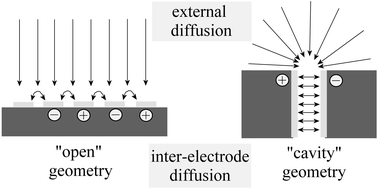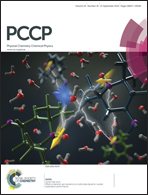Cavity transport effects in generator–collector electrochemical analysis of nitrobenzene
Abstract
Two types of generator–collector electrode systems, (i) a gold–gold interdigitated microband array and (ii) a gold–gold dual-plate microtrench, are compared for nitrobenzene electroanalysis in aerated aqueous 0.1 M NaOH. The complexity of the nitrobenzene reduction in conjunction with the presence of ambient levels of oxygen in the analysis solution provide a challenging problem in which feedback-amplified generator–collector steady state currents provide the analytical signal. In contrast to the more openly accessible geometry of the interdigitated array electrode, where the voltammetric response for nitrobenzene is less well-defined and signals drift, the voltammetric response for the cavity-like microtrench electrode is stable and readily detectable at 1 μM level. Both types of electrode show oxygen-enhanced low concentration collector current responses due to additional feedback via reaction intermediates. The observations are rationalised in terms of a “cavity transport coefficient” which is beneficial in the dual-plate microtrench, where oxygen interference effects are suppressed and the analytical signal is amplified and stabilised.


 Please wait while we load your content...
Please wait while we load your content...